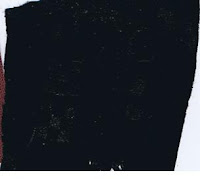Here are a selection of synthetic, from lace, to felt, to lame'
Below, I have traced around a motif in some lace with the straight tip on the heat tool. It creates a sealed edge that can be appliqued without fraying.
You can trace/cut around quite complicated motifs this way.
It works extremely well on Lutradur.
This lame' frays very easily, but the shape burned out will not fray.
The same is true for this satin.
You can also use some of the other heads to emboss, or burn patterns into fabric. This works really well on velvet. Above tou can see a flat circular head and a nine patch sort of head. If you want to emboss instead of burn you need to be able to lower the heat on your tool.
Here are some applique leaves and motifs cut out.
- from very thin chifon/organza
- from plastic garbage bags
- lame
- a shot satin
- silk
- several layers og garbage bag plastic (seals them together)
- Lace
- crushed velvet
- satin
- an embossed satin

Using the circular head on plastic at a hot heat, then layering two colours
Cutting out bubble wrap then melting the bubbles over a foil base
In these two lutradur samples, I have cut out a design with the straight tool, and burned with the shape tools.
In this satin sample, the melted fabric made strands as I pulled the tool away. I definitely need to repeat this.
In this lutradur sample layered over a purple background, the left circles went totally through, whilst the right citcles only went halfway forming a fine lace. I liked that.
In these to samples I was experimenting with getting the leaf to stitck to the fabric underneath. It wasonly a partial success.
These two are embossed crushed velvet. because the velvet was black, It is very hard to see the embossing here, but it is very visible when looking at it in reality.
Here I have both fully burned and partially burned lame. The sample on the right is burning lame onto felt, which requires a higher heat to melt
If you look carefully, you can see the embossed circle on this shot satin.
Lame and organza on felt.
Here is the large lace motif burned out.
These textured satins were perfect for cutting geometrics out. This would be a great addition to some cut work.
These two examples on black silk (which also needs a higher heat) were some scraps of fused fabrics I had. I was not sure if it was a good idea to use them, but I am glad I did. Since these were sheers, I put a little angelina between the two layers, I wanted to see if I could trap the angelina in between. It worked, but I also discovered something else.
If the top fabric has fusible on the back, when you burn around it, you also fuse it to the background (so long as the background has a higher melting point). Wow! I found this such and exciting discovery that I tried a lot of fused fabrics on some brocade (below).
- grey satin
- green garbag plastic
- white metallic organza
- textured satin
- loose weave organza
- velvet ribbon
- lutradur
I simply put a piece of fusible larger than the shape (without the paper backing), between the two layers before I burned the line and it worked! So not only does this fuse the fabrics to the background, you don't have to iron any fusing first.
I would not trust this to be permanent, since the fusing is only a fine line, but for me it was a great discovery.
Using this method, you could have beautiful synthetic appliques (which are usually fiddly because the fabric is slippery, and can't be fused because the fabric will melt). The appliques would easily stay in place for stitching, and because the fusible is not ironed in the centre, they would stay soft.
I will have to experiment with washing after stitching to see what happens to the unironed fusible, but my guess is it is so fine, it would not bea problem.
WOW - I feel like shouting Eureka! I am most certainly going to use this in my secret activity that I told you I would tell you about soon.
Did you hear that girls? Here's my first technique.
So excited. No quote today
Oh and I got the book I won from workshop on the web yesterday
I am really enjoying reading it and looking forward to doing the free online tutorials that go with it.
Vicki




































